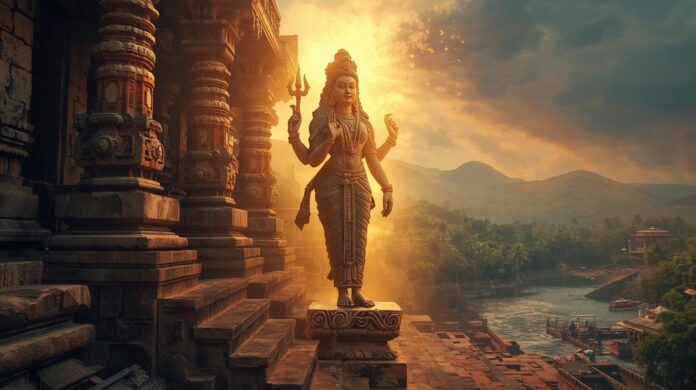In our country several cults within the fold of Hinduism have flourished with the passage of time. Shaktism or the Shakta cult is one of them which is not only old but also very popular throughout the length and breadth of the country. From Kashmir to Kanyakumari and from Dwarika to Kamakhya, Shakti or Devi Peethas can be found everywhere. In addition to the Peethas created out of the pieces of Devi Sati’s body falling on certain places when Lord Vishnu cut it so that the anger of Lord Siva could be mitigated, there are countless local Devis or goddesses who can be found in every village and town of the country. This bears testimony to the extreme popularity of the Devi cult.
Like India, Odisha also does not lag behind in the matter. From Nuapada to Puri and from Malkangiri to Balasore, the state is full of Devi Peethas. The cult is not only very old but also popular in the state. People have great reverence for her and in almost all the Peethas festivities are organised by the local people throughout the year, mostly during Dussehra and Chaitra. Maa Bhattarika is one such popular goddess in the state though her temple is confined only to a few places. She is of great mythical and cultural importance.
The Myth — The meaning of Bhattarika is “the Saviour”. Having been based on a mythical backdrop, the naming is justified. Myth has it that Veer Parshuram wanted to take revenge on Sahasrarjuna who had killed his father. But he got defeated in the battle. So he moved from place to place till he reached the present Peetha of Maa Bhattarika where his arrow fell from his hands. Realising the importance of the place and its miraculous power, Veer Parshuram drew the picture of Maa Bhattarika on a stone with his arrow. He did this to spread the glory of the Devi. Then he got the blessings of Maa Bhattarika and was able to take revenge on the Kshyatriyas. At a later time, a king built a temple on the spot and since then the Devi is being worshipped.
The Peetha — Maa Bhattarika Peetha is pitted against a backdrop of great natural beauty. It is approximately six miles from Badamba in the district of Cuttack. The place is surrounded by Khandapada in the south, Tigiria in the east, Narasinghapur in the west and Hindol in the north. The natural beauty of Bhattarika is extremely captivating. The river Mahanadi is flowing nearby. On the other side of the river there are hills standing like a boundary. The heavenly beauty around Bhattarika brings peace and solace to the human mind, otherwise being suffocated leading a fast and material life.
The Neelamadhava temple of Kantilo can be viewed from Maa Bhattarika Peetha. The boatsmen pray to the Devi for a safe journey before sailing on their boats. Maa Bhattarika is surrounded by ‘Ashta Thakurani’ or eight Devis. At the same time, ‘Chari Mahadev’ or four Mahadevs also surround the Devi. They are Dhabaleswar, Rameswar, Kapileswar and Somanath for whom there is special provision for ‘Charithali Bhoga’. There is a temple dedicated to Veer Hanuman on the opposite side of the temple.
Festivity — There is a huge gathering over here on the occasion of Ashwina Dwitiya. Devotees come from far and wide. For the worship of the Devi there are special priests. ‘Sakala Dhupa’ (Sakala Ballabha), ‘Sandhya Alati’ and ‘Ratri Bhog’ are the daily rituals for Maa Bhattarika. Makara Sankranti, Pana Sankranti, Akshaya Tritiya and Dussehra are the main festivals observed in the Peetha every year.
It is seen that the Shakta cult is very popular in our country and most Devis or goddesses have had a local origin, though some of them might have acquired a regional or even national status in the course of time. As for instance, Maa Ghanteswari in Sambalpur and Maa Bhattarika near Badamba have had a humble origin, but their popularity has reached a regional stature. The original Peetha of Bhattarika may have been located near Badamba since the Treta Yuga as it is believed, but there is another Peetha dedicated to the Devi in Odisha.
The second Maa Bhattarika Peetha is in the village of Kumbharbandh which is approximately 90 kilometres from Sambalpur (via Jharsuguda) and 40 kilometres from Jharsuguda. The village is in the district of Jharsuguda.
Backdrop — Kumbharbandh is a pristine village approximately 40 kilometres from Jharsuguda, the district headquarters. It is believed that in the past many potters lived in the village who constructed dams or ponds. Since in local language a pond is called ‘bandh’, the village has got its name accordingly. The village is also inhabited by the Yatukarna Gotriya Aranyak Brahmins who have installed Maa Bhattarika, their family goddess or presiding deity, on a hillock on the outskirts of the village. The Yatukarna Brahmins trace their lineage to sage Kashyap.
Temple — The present temple, having been situated on top of a hill, was completed in the year 1994 with commencement of Puja. It took long twelve years for construction of the temple. At the entrance, there is a gate with good architecture and displaying various forms of Devi Durga. There are stairs from the main gate reaching up to the temple. It is an Ashtachandi Peetha and Maa Bhattarika is called Tripurasundari Maa Surya Bhattarika. The idol of the Devi in the Garvagriha is made of marble. Having been built in a modern style, the temple is surrounded by the temples of Lord Siva and Veer Hanuman constructed independently. The temple complex is calm, quiet and serene with natural scenic beauty around. The Rampela bridge built over the Ib river nearby presents a breathtaking sight.
Festivity — Daily worship of Maa Surya Bhattarika is done from 9 AM to 11 AM and from 5 PM to 6 PM. ‘Sunabesha’ of the Devi is done every Tuesday. A ‘Chandipatha Puja’ is done on the full moon of the Chaitra month. Every year, ‘Chaitra Mela’ is organised during the month of Chaitra which draws thousands of devotees from neighbouring areas. Animal sacrifices are strictly prohibited at the shrine. The temple owns some landed property which helps in its maintenance. Maa Surya Bhattarika is benevolent and powerful. She fulfils the aspirations of her devotees and releases them from their misery. Maa Surya Bhattarika sits on a lotus. Wherever she is, whether it is Badamba or Kumbharbandh, she never disappoints her devotees and grants them whatever they ask for. She is benevolent and kind Mother personified. ‘Brata’ or Thread Ceremony of the Brahmin community is solemnised in the temple round the year.
Communications — The pristine village of Kumbharbandh, where the temple is located, is approximately forty kilometres from the town of Jharsuguda. A few buses run from Jharsuguda to Kumbharbandh daily. One can also use personal or hired vehicles to reach the spot from Jharsuguda which is also a railway junction. From Sambalpur also there is a motorable road up to Kumbharbandh via the Rampela bridge and the distance is forty kilometres approximately. Though from October to March is the best time to visit the place, in addition to Dussehra and Chaitra, the shrine can be visited at any time of the year for a darshan of the benevolent Devi.
There are many places like the village of Kumbharbandh and the shrine of Maa Surya Bhattarika in our country, state and region which should come to limelight. Since most of these places are situated in a calm and quiet place with fabulous scenic beauty, the government can earmark and take steps for the development of tourism as well. More and more people with families should visit the shrine of Maa Surya Bhattarika at Kumbharbandh for her blessings.
views expressed are the writer’s own)

Mr. Prafulla Kumar Majhi,
Retired Asst. Director, A. I. R, is an eminent Scholar and freelance writer in English & Odia. His areas of interests are sociocultural, economic, literary, historical and analytical studies and writings.
Email: airprafulla61@gmail.com
Mobile.9861007190

